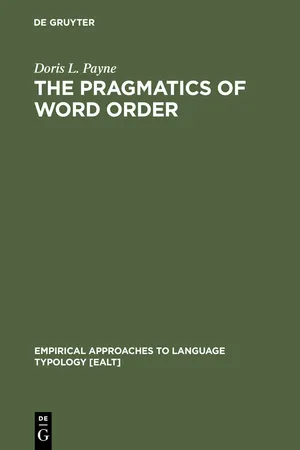
eBook - PDF
The Pragmatics of Word Order
Typological Dimensions of Verb Initial Languages
- 309 pages
- English
- PDF
- Available on iOS & Android
eBook - PDF
About this book
No detailed description available for "The Pragmatics of Word Order".
Frequently asked questions
Yes, you can cancel anytime from the Subscription tab in your account settings on the Perlego website. Your subscription will stay active until the end of your current billing period. Learn how to cancel your subscription.
At the moment all of our mobile-responsive ePub books are available to download via the app. Most of our PDFs are also available to download and we're working on making the final remaining ones downloadable now. Learn more here.
Perlego offers two plans: Essential and Complete
- Essential is ideal for learners and professionals who enjoy exploring a wide range of subjects. Access the Essential Library with 800,000+ trusted titles and best-sellers across business, personal growth, and the humanities. Includes unlimited reading time and Standard Read Aloud voice.
- Complete: Perfect for advanced learners and researchers needing full, unrestricted access. Unlock 1.4M+ books across hundreds of subjects, including academic and specialized titles. The Complete Plan also includes advanced features like Premium Read Aloud and Research Assistant.
We are an online textbook subscription service, where you can get access to an entire online library for less than the price of a single book per month. With over 1 million books across 1000+ topics, we’ve got you covered! Learn more here.
Look out for the read-aloud symbol on your next book to see if you can listen to it. The read-aloud tool reads text aloud for you, highlighting the text as it is being read. You can pause it, speed it up and slow it down. Learn more here.
Yes! You can use the Perlego app on both iOS or Android devices to read anytime, anywhere — even offline. Perfect for commutes or when you’re on the go.
Please note we cannot support devices running on iOS 13 and Android 7 or earlier. Learn more about using the app.
Please note we cannot support devices running on iOS 13 and Android 7 or earlier. Learn more about using the app.
Yes, you can access The Pragmatics of Word Order by Doris L. Payne in PDF and/or ePUB format, as well as other popular books in Languages & Linguistics & Linguistics. We have over one million books available in our catalogue for you to explore.
Information
Table of contents
- Acknowledgements
- Abbreviations
- Chapter One. Introduction
- 1.1. Genetic and typological affiliations
- 1.2. Demography and ethnography
- 1.3. Previous linguistic work on Peba-Yaguan
- 1.4. Data for the current study
- Chapter Two. Constituent Order and Order Correlations
- 2.1. Observations of constituent order co-occurrences
- 2.2. The verb initial norm (VIN)
- 2.3. Selected theoretical approaches accounting for word order correspondences
- 2.4. Identification of basic constituent order
- 2.5. Towards an adequate constituent order typology
- Chapter Three. Clausal Phenomena
- 3.1. Major structural clause types
- 3.2. Impersonals and functionally related constructions
- 3.3. Auxiliaries
- 3.4. Second position clitics
- 3.5. Causation and desideration
- 3.6. Parataxis
- 3.7. Negatives and modals
- 3.8. Questions
- 3.9. Comparatives and equatives
- 3.10. Coordination and alternative relations
- 3.11. Complex sentences
- 3.12. Summary
- Chapter Four. Noun and Postpositional Phrase Phenomena
- 4.1. Bound modifying roots
- 4.2. Determination of head versus modifier within noun phrases
- 4.3. Order of head noun and descriptive modifier in text
- 4.4. Complex modifying phrases
- 4.5. Genitives
- 4.6. Postpositional phrases
- 4.7. Summary
- Chapter Five. Noun Classification and Nominalization
- 5.1. Derivational uses of classifiers
- 5.2. Inflectional uses of classifiers
- 5.3. Anaphora and classifiers
- 5.4. Theoretical status of Yagua classifiers
- Chapter Six. The Verb Phrase and Related Issues
- 6.1. Verbal nexus
- 6.2. Adverbs
- 6.3. Subject - object asymmetries: Evidence for a verb phrase containing the object?
- 6.4. Incorporation
- 6.5. An overview of verbal morphology
- 6.6. The instrumental/comitative -ta
- 6.7. Morphological causatives with -tániy
- 6.8. Summary
- Chapter Seven. Pragmatic Factors Motivating Order Variation
- 7.1. General pragmatic structure of Yagua clauses
- 7.2. The pragmatically marked nucleus
- 7.3. Function of the PM’ component
- 7.4. Functions of the PM component
- 7.5. Summary of pragmatically marked types
- 7.6. Frequency distribution of syntactic constituent orders
- 7.7. Relative order of direct objects and obliques
- 7.8. Summary
- Chapter Eight. Constituent Order in Yagua: Conclusions and Implications
- 8.1. Arguments in favor of SVO as basic
- 8.2. Arguments against SVO as basic
- 8.3. Summary of typological traits
- 8.4. Implications for head-dependent ordering principles and Hawkins’ Universals
- 8.5. Yagua as a head marking language
- Appendix 1: Lagarto (Alligator) Text
- Appendix 2: Phonology
- Notes
- References
- Index